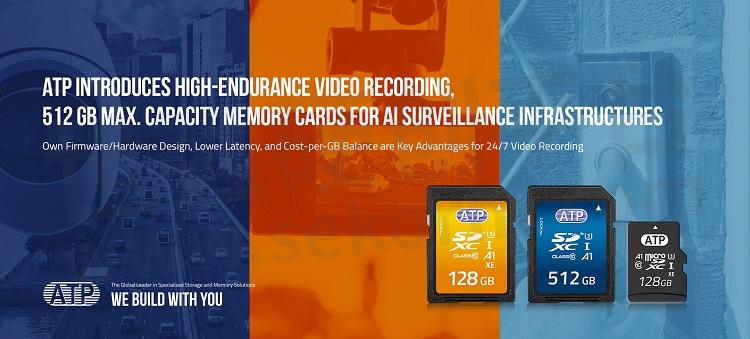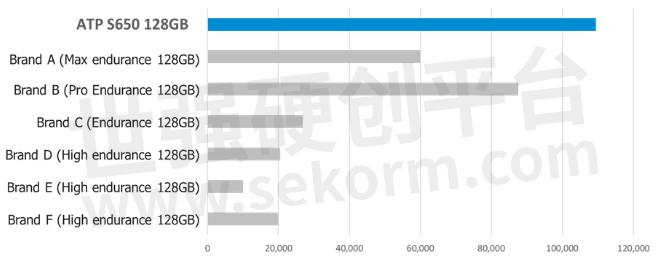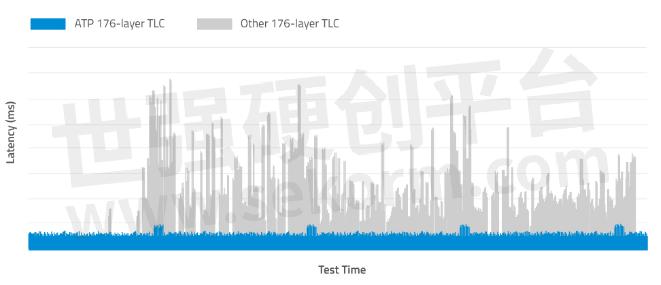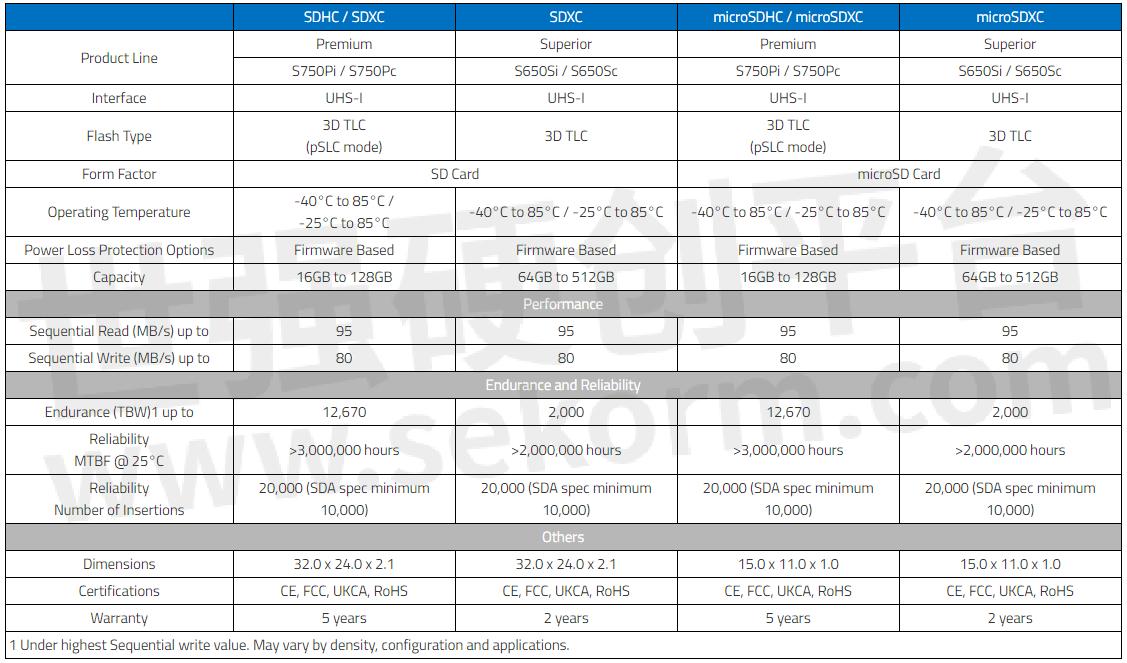ATP Introduces High-Endurance Video Recording, 512GB Max. Capacity Memory Cards for AI Surveillance Infrastructures





ATP Electronics, the global leader in specialized storage and memory solutions, introduces its new S650Si (TLC) and S750Pi (pSLC) Series SD and microSD memory cards built with 176-layer 3D NAND technology and low-density parity check (LDPC) controller.
With expanded capacity offerings up to 512 GB and 5-year extended supply longevity support, the new memory cards are targeted for growing segments spurred by 5G, artificial intelligence (AI), and edge technologies, such as AI-enabled surveillance, smart homes, mobile monitoring, automotive recorders, remote healthcare, and security surveillance systems requiring heavy write and re-write usage.
High Endurance: Best-in-Class Cost-per-GB Memory Card Solutions
Native TLC mode
High endurance is critical in any non-stop recording environment. With capacities ranging from 64 GB to 512 GB, the S650Si Series is rated for 5K+ P/E cycles and Terabytes Written (TBW) of up to 2,000 TB.
pSLC configuration
For customers requiring an even higher-endurance solution, the S750Pi Series pseudo single level cell configuration offers up to 100K+ P/E cycles and TBW rating of up to 12,670 TB. These memory cards are available in capacities from 16 GB to 128 GB.
Both configurations are I-Temp operable and feature power loss protection technology, making them suitable for systems installed in extreme conditions with temperature shifts from -40℃ to 85℃ and unstable power supply settings. Compared with previous-generation ATP SD/microSD offerings, the new memory cards also offer 3X faster sequential write and better sustained writing performance.
The graph below shows that based on 13 Mbps (lowest bitrate of HD recording) tested at 128 GB capacity point, ATP's 176-layer TLC cards do not only deliver extended recording hours compared to competitors with the same storage capacity but also present a cost-effective solution for video recording.

1. Tested using 128 GB ATP S650 TLC card based on 13 Mbps (lowest bitrate of HD recording) in best-case/ideal scenario, with no other influencing factors.
2. Information sourced by ATP from publicly available data. To record new data, the oldest data will be overwritten when the card is full. 1Mbps=1,000,000 bps
AI Surveillance Infrastructures: We Build With You
With the rapid advancement of AI technology and the proliferation of edge computing infrastructure and applications, ATP is fully capable of addressing diverse, application-specific needs through its mass production infrastructure. ATP-developed firmware and hardware configurations can meet customers' unique requirements.
ATP SD Life Monitor: Intelligent Workload Inspection
ATP's SD Life Monitor tool provides "Workload Inspection." This gives customers a quick look of the write operation and file size by the host systems pre-qualification. The information is presented as a pie graph for ease of monitoring.
Considering the NAND flash page size and FW algorithm, ATP then provides recommendations and more information for the host devices' program data based on the multiples of minimum data transfer size in SD/microSD card datasheet.
Upon tuning according to workload inspection, ATP's memory cards exhibited consistent latency performance when compared to untuned memory card solutions.
Stable latency ensures consistent performance even after long-term writing, ensuring good-quality continuous video recording. This is especially important for applications like digital video recorders (DVRs), where unexpected latency can result in frame dropping or low recording quality.
In the following graph, ATP's TLC solutions with optimized latency (blue) maintain stable performance, which ensures high quality real-time video recording even after long-term writing. In contrast, unoptimized solutions (gray) show latency spiking up after a period of programming.

Joint Validation Service
ATP performs compatibility and function tests using client-supplied host devices and systems to proactively detect and minimize failures that may not have been caught in production tests. Below are joint validation tests optimized according to application needs.
Software Joint Integration
Compatibility Study and Test
Device Signal Measurement
Function/Performance Enhancement
Additional tests (e.g., Industrial Standard, Power Cycling Test)
Advanced Card Analysis
System-in-Package (SiP) wafer/die process makes ATP memory cards resistant to water, dust, and shock; however, it also makes it difficult to perform component analysis compared to SMT (surface- mount technology) process. ATP's uniquely designed substrate and debug tool make post-analysis possible.
Specifications

- +1 Like
- Add to Favorites
This document is provided by Sekorm Platform for VIP exclusive service. The copyright is owned by Sekorm. Without authorization, any medias, websites or individual are not allowed to reprint. When authorizing the reprint, the link of www.sekorm.com must be indicated.
Recommend
SMART Modular Technologies Introduces New Family of CXL Add-in Cards for Memory Expansion in High Performance Servers
2024-04-26 - Product Introduction SMART announces its new family of Add-In Cards which implements the CXL® standard and also supports industry standard DDR5 DIMMs. These are the first in their class, high-density DIMM AICs to adopt the CXL protocol. They enable Data Center, Cloud Services, and HPC Providers to Easily and Cost-Effectively Expand Memory Capacity for Memory Intensive Compute Applications.
Two FORESEE Memory Cards Added to the Approved Vendors List (AVL) of Raspberry Pi Computers, Taking Compatibility to a New Level
2023-12-13 - Product Introduction Recently, FORESEE EPLUS series microSD and industrial microSD products have been officially added to the AVL of Raspberry Pi computers, marking a significant breakthrough for the platform compatibility of FORESEE‘s mobile storage product line.
High-Endurance, Low-Latency SD/microSD Cards Built for Dashcams, DVRs Offer Over 109K Hours of Continuous Video Recording
2022-07-23 - New Product Introduction ATP Electronics introduces its new 3D TLC S750/S650 Series SD and microSD memory cards built for the rigors of non-stop video recording. They meet the high endurance, low latency, and built-to-last data storage requirements of dashcams and DVRs, and other write-intensive applications.
Endurance, Latency, and Workload Considerations for Choosing Dashcam Memory Cards (Part 1)
2022-08-11 - Technical Discussion To record videos non-stop for thousands of hours without compromising data integrity, you will need high-endurance memory cards. In this article, ATP ELECTRONICS tells the recording challenges and shows what should we consider when choosing a memory card for recording.
microSD/microSDHC/microSDXC Card
2025/07/02 - Datasheet
S750PI/S750PC,S800PI,S600SI/S600SC,S700PI/S700PC,S650SI/S650SC
查看更多版本Ensuring NAND Flash and Data Integrity of Dashcam Memory Cards (Part 2)
2022-09-02 - Technical Discussion In this article, ATP presents three most frequent causes of data corruption, their fixes, and an enhanced analysis approach based on NAND technology and user behaviours. New S650/S750 Series SD meet the high endurance, low latency, built-to-last data storage requirements of dashcams.
ATP 3D NAND-Based Memory Cards Meet Growing IoT /IIoT Storage Needs, with Industrial Temperature Ratings of -40℃ to 85℃
2023-11-24 - Manufacturer News ATP‘s industrial-grade SD and microSD cards based on 3D NAND technology meet the growing data storage needs of the IoT/IIoT. Thanks to these tiny and low-power yet powerful removable data collection solutions, gateways can store huge amounts of data closer to the source, providing local intelligence and ensuring Internet-independent operation even in the event of connection outages.
SD/SDHC/SDXC Card
2025年6月20日 - Datasheet
S800PI,S750PI / S750PC,S600SI / S600SC,S700PI / S700PC,S650SI / S650SC
查看更多版本ATP Exhibits at Embedded World 2024
2024-03-29 - Manufacturer News Participants should not miss a visit to ATP’s Booth in Hall 1-210, where ATP once again demonstrates its commitment to redefine memory and data storage reliability, scalability, and efficiency. Attendees to Embedded World 2024 can expect to see a new breed of flash storage solutions with ATP’s 176-layer NAND flash innovation, industrial enterprise-readiness for Edge computing and artificial intelligence, and latest DDR5-5600 memory offerings.
ATP “Industrial Only” Memory Cards: Gateways to the Intelligent Edge in the Smart Factory
2022-11-03 - Manufacturer News ATP A1 cards use 3D MLC NAND flash for enhanced reliability and endurance and are best used in applications requiring exceptional levels of data integrity and responsiveness.
ATP “Industrial Only“ Memory Cards Meet Healthcare Applications Demands
2023-10-28 - Application solution Article With ATP‘s nearly three decades of experience in offering industrial memory, storage solutions, and a one-stop shop to fulfill the demand for data storage in the medical industry, ATP can surely be an integral cogwheel to help shape and create a better world.
SD/SDHC/SDXC Card The Global Leader in Specialized Storage and Memory Solutions
082024 - Supplier and Product Introduction
S750PC,S650SI,S700PI,S600SC,S800PI,S700PC,S600SI,S750PI,S650SC
查看更多版本microSD/microSDHC/microSDXC Card The Global Leader in Specialized Storage and Memory Solutions
082024 - Supplier and Product Introduction
S750PC,S650SI,S700PI,S600SC,S800PI,S700PC,S600SI,S750PI,S650SC
查看更多版本ATP Electronics Showcases the Smallest, Most Powerful, and Greenest AI Memory and Storage Solutions at COMPUTEX Taipei
2025-05-07 - Manufacturer News Featured extreme solutions for the “AI Next” generation include the 7.2 mm e.MMC in the world’s smallest package; industrial solid state drives (SSDs) with record-breaking, highest-endurance ratings; and, industrial enterprise storage optimized for the toughest edge AI demands. ATP also marks a significant milestone with the upcoming opening of its new smart manufacturing facility in Kaohsiung, Taiwan, underscoring the company’s commitment to eco-sustainability by using technology to reduce environmental impact.
ATP Launches Customizable SecurStor microSD Cards with Secure Boot and HW AES-256 XTS Encryption
2021-04-24 - Manufacturer News ATP Electronics, the global leader in specialized storage and memory solutions, has launched the SecurStor microSD cards – the latest in its line of secure NAND flash storage products for the Internet of Things (IoT), education, automotive, defense, aerospace and other applications requiring confidentiality and reliability.
Electronic Mall
 Auth. Dist.
Auth. Dist.
 Auth. Dist.
Auth. Dist.
 Auth. Dist.
Auth. Dist.
 Auth. Dist.
Auth. Dist.
 Auth. Dist.
Auth. Dist.
 Auth. Dist.
Auth. Dist.
 Auth. Dist.
Auth. Dist.
 Auth. Dist.
Auth. Dist.
 Auth. Dist.
Auth. Dist.
Integrated Circuits
Discrete Components
Connectors & Structural Components
Assembly UnitModules & Accessories
Power Supplies & Power Modules
Electronic Materials
Instrumentation & Test Kit
Electrical Tools & Materials
Mechatronics
Processing & Customization

























































































































































































































































































































































































































































































































































































































































































































































































































































































































































































